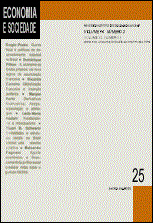Resumen
O objetivo deste estudo é contribuir para o desenvolvimento teórico da coordenação vertical em sistemas produtivos, elaborando o conceito de “estabilidade e difusão de arranjos contratuais”. Considerando o paradigma do alinhamento eficiente das características da transação com o arranjo contratual, espera-se que os arranjos mais eficientes difundam-se e substituam aqueles menos eficientes. Esse processo pode ser descrito por uma curva logística ao longo do tempo, com potencial aplicação na elaboração de alianças estratégicas em cadeias agroalimentares. A coexistência de arranjos contratuais alternativos é um enigma para a literatura que se baseia no alinhamento eficiente e pode ser explicada por: (1) situações de desequilíbrio, (2) barreiras para a adoção do arranjo contratual novo e superior devido à existência de rotinas não replicáveis e (3) efeitos do ambiente institucional no nível de adoção de determinado arranjo. O conceito é exemplificado na indústria avícola brasileira, explorando-se sua utilidade para o estudo de estratégias cooperativas em cadeias agroalimentares e sugerindo estudos empíricos posteriores.
Abstract
The objective of this study is to contribute for the theoretical development of vertical coordination in productive systems, shaping the concept of “stability and diffusion of contractual arrangements”. Considering the well-accepted statement of efficient alignment between transaction characteristics and contractual arrangement, more efficient arrangements are expected to diffuse and replace less efficient ones. This process can be described by a logistic curve along the time, with potential application for designing strategic alliances in food chains. The coexistence of alternative contractual arrangements is a puzzle in the literature that stresses the efficient alignment and can be explained by: (1) disequilibrium situations, (2) barriers for adoption of new and superior contractual architectures due to non replicable routines and (3) effect of institutional environment on the level of adoption of a specific arrangement. The concept is exemplified by the poultry production system in Brazil, stressing its usefulness for the study of cooperative strategies in food chains and suggesting further empirical studies.
Key words: Contractual arrangements – Stability, Diffusion. Vertical coordination
Citas
COOK M. L., CHADDAD, F. R. Agroindustrialization of the global agrifood economy: bridging development economics and agribusiness research. Agricultural Economics, v. 23, n. 3, p. 1-12, 2000.
GRILICHES, Z. Hybrid Corn: an exploration in the economics of technological change. Econometrica, v. 25, n. 4, p. 501-522, 1957.
GROSSMAN, S. J., HART, O. D. The costs and benefits of ownership: a theory of vertical and lateral integration. Journal of Political Economic, v. 94, n. 4, p. 691-719, 1986.
HARRIS, M., HOLMSTROM, B. On the duration of agreements. International Economic Review, v. 28, n. 2, p. 389-406, 1987.
HART, O. D., MOORE, J. Incomplete contracts and renegotiation. Econometrica, v. 56, p. 755-785, 1988.
JOSKOW, P. L. Vertical integration and long term contracts. The case of coal burning electric generation plants. Journal of Law, Economics and Organization, v. 1, p. 33- 79, 1985.
KAY, N. M. Clusters of collaboration: the firms, joint ventures, alliances and clubs. In: FOSS, J. N., LOASBY, B. J. Economic organization, capabilities and coordination. Routledge Studies in Business Organization and Networks, 1998.
KLEIN, B. Contracts and incentives: the role of contracts terms in assuring performance. In: WERIN, L., WIJKANDER, H. Contracts economics. Oxford: Blackwell, 1992. p. 59.
LANGLOIS, R. N. Transaction cost economics in real time. In: RESOURCES, firms and strategies. Oxford Management Readers, 1997.
________. Capabilities and the theory of the firm. In: FOSS, J. N., LOASBY, B. J. Economic organization, capabilities and coordination. Routledge Studies in Business Organization and Networks, 1998.
LOASBY, B. The concept of capabilities. In FOSS, J. N., LOASBY, B. J. Economic organization, capabilities and coordination. Routledge Studies in Business Organization and Networks, 1998.
MAHONEY, J. T., PANDIAN, J. R. The resource based view within the conversation of strategic management. Strategic Management Journal, v. 13, p. 363-380, 1992.
________, CRANK, D. A., LAJILI, K. Spot markets, vertical contracting, and vertical financial ownership: competition among organizational forms. Presented at Conferência de Pesquisa NE-165/WRCC-72 – Interactions Between Public Policies and Private Strategies in the Food Industries. Montreal, Quebec, 1994.
MASTEN, S. E. Contractual choice. In BOUKAERT, B., GEEST, D (Org.).
Encyclopedia of Law & Economics. Edward Elgar Publishing and the University of Ghent, 1998.
MENARD, C. The economics of hybrid organizations. In: CONGRESS OF INTERNATIONAL SOCIETY FOR THE NEW INSTITUTIONAL ECONOMICS, 2002. Cambridge, MA: Massachussets Institute of Technology – MIT, 2002.
OLSON, M. The logic of collective action: public goods and the theory of groups. Harvard University Press, 1965.
PENROSE, E. (1959). The theory of the growth of the firm. Oxford: Basil Blackwell/ Oxford University Press, 1995.
RAYNAUD, E., SAUVÉE, L., VALCESCHINI, E. Quality enforcement mechanisms and the governance of supply chains in European food system. In: CONFERENCE OF THE INTERNATIONAL SOCIETY FOR THE NEW INSTITUTIONAL ECONOMICS, 2002. Cambridge. MA, 2002.
RICHARDSON, G. B. The organization of industry. Economic Journal, v. 82, p. 883- 892, 1982.
SAUVÉE, L. Toward an institutional analysis of vertical coordination in agribusiness. In: ROYER, J. S., ROGERS, R. T. (Org.). The industrialization of agriculture. [s.l.: s.n.], 1998.
TEECE, D. J., PISANO, G. The dynamic capabilities of firms: an introduction. Industrial and Corporate Change, v. 3, p. 537-556, 1994.
WILLIAMSON, O. E. The economic institutions of capitalism: firms, markets and relational contracts. New York: Free Press, 1985.
WILLIAMSON, O. E. Comparative economic organization: the analysis of discrete structural alternatives. Administrative Science Quarterly, v. 36, p. 269-296, 1991.
________. Why law, economics, and organization? UC Berkeley Public Law and Legal Theory Working Paper Series. Social Science Research Network Paper Collection, 2000. Available from <http://papers.ssrn.com/paper.taf?abstract_id=255624>. Acesso em dez. 2000.
ZYLBERSZTAJN, D., FARINA, M. M. Q. Strictly coordinated food systems: exploring the limits of the Coasian firm. International Food and Agribusiness Management Review, v. 2, n. 2, 1999.
________, LAZZARINI, S. G. On the survival of contracts: A study of contract stability in the Brazilian seed industry. In: CONFERENCE OF INTERNATIONAL SOCIETY FOR THE NEW INSTITUTIONAL ECONOMICS, St. Louis, 1997.
A Economia e Sociedade utiliza a licença do Creative Commons (CC), preservando assim, a integridade dos artigos em ambiente de acesso aberto.

